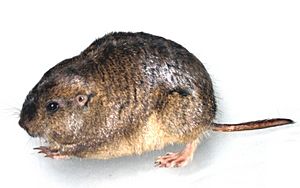Haig's tuco-tuco facts for kids
Quick facts for kids Haig's tuco-tuco |
|
|---|---|
 |
|
| Female | |
| Conservation status | |
| Scientific classification | |
| Genus: |
Ctenomys
|
| Species: |
haigi
|
| Subspecies | |
|
C. h. haigi Thomas, 1917 |
|
Haig's tuco-tuco, also known as the Patagonian tuco-tuco, is a type of rodent. It is part of a group called hystricognaths, which are rodents with a special jaw and teeth. Like other tuco-tucos, this animal lives mostly underground in burrows. Because they stay hidden, it's not easy to spot them. However, you might hear the males making a "tuc-tuc" sound, especially early in the morning near their burrow entrances. Most tuco-tucos, including Haig's tuco-tuco, are solitary animals. This means that each adult usually lives alone in its own burrow.
Where Haig's Tuco-Tuco Lives
Haig's tuco-tuco is originally from Argentine Patagonia. This is a large region in the southern part of South America.
Natural Homes
These tuco-tucos mainly live in the Patagonian steppe. A steppe is a large area of dry grassland. They can also be found in other natural areas:
- The Low Monte ecoregion, which is a dry shrubland.
- The Valdivian temperate rain forest ecoregion, which is a cooler, wetter forest area.
See also
 In Spanish: Tuco-tuco patagónico para niños
In Spanish: Tuco-tuco patagónico para niños


